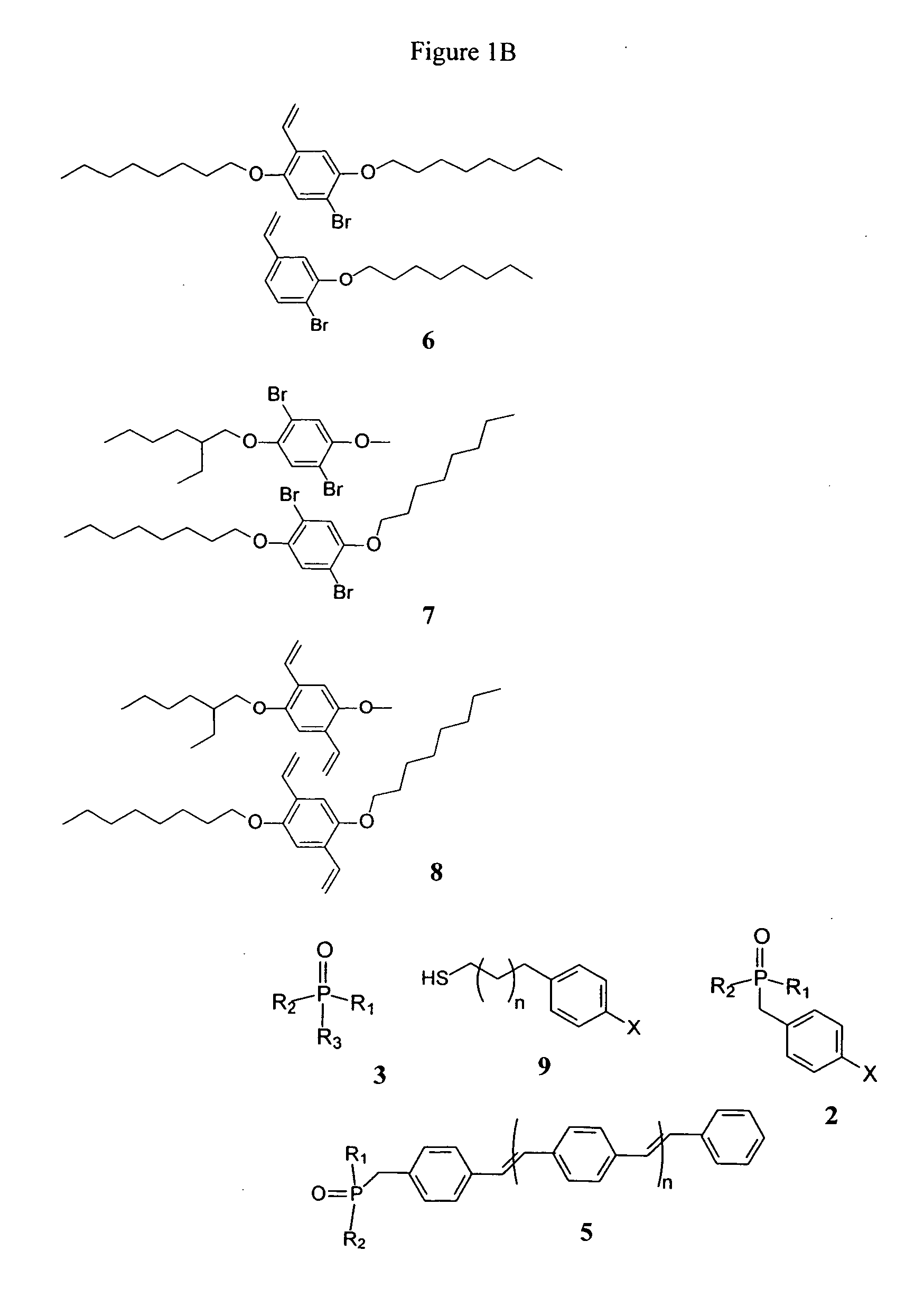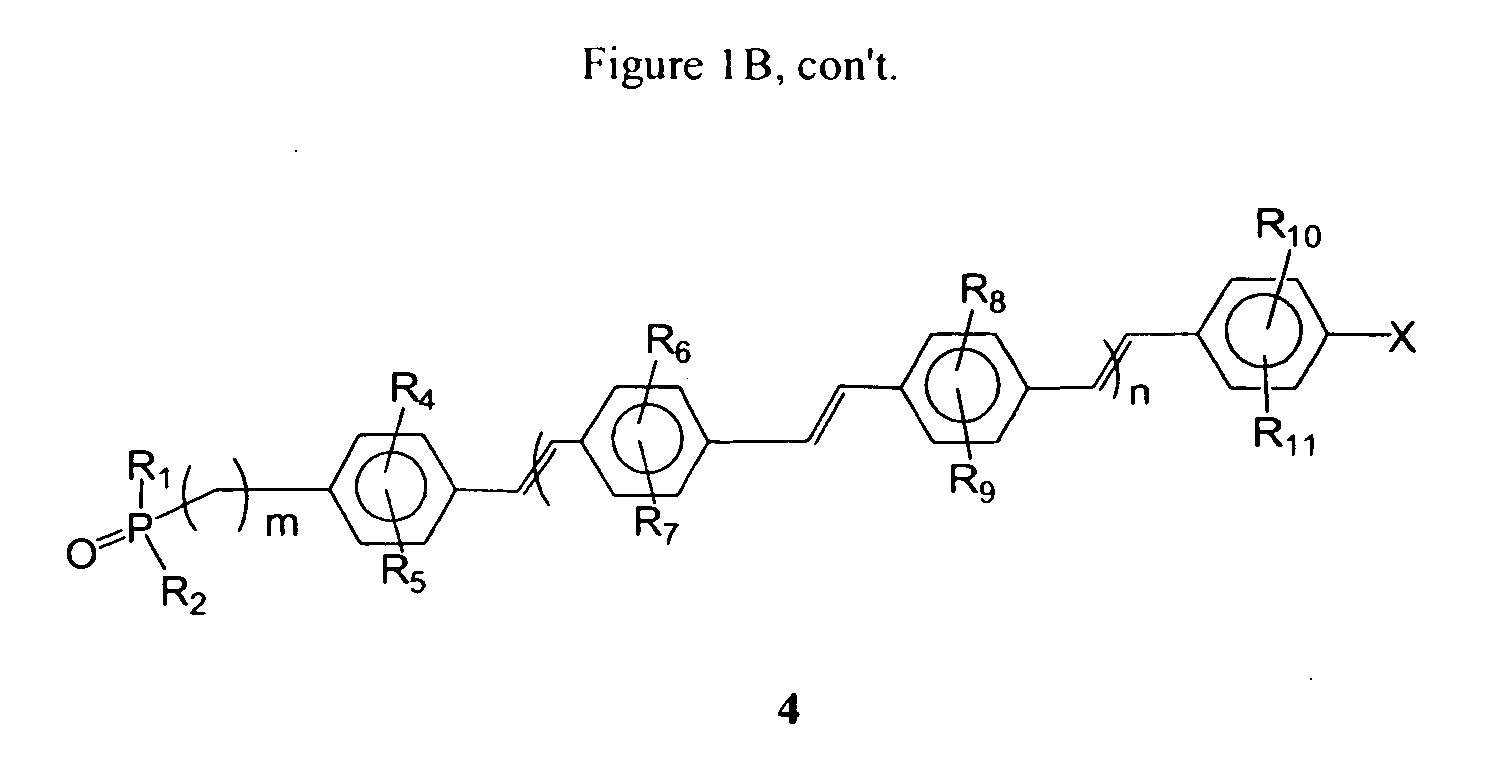Quantum dots tailored with electronically-active polymers
a polymer and electronic technology, applied in nanoinformatics, organic chemistry, group 5/15 element organic compounds, etc., can solve the problems of reducing the efficiency of nanoparticle synthesis, so as to maximize interfacial contact and charge transport, reduce the loading of nanoparticles, and maximize the effect of dispersal
- Summary
- Abstract
- Description
- Claims
- Application Information
AI Technical Summary
Benefits of technology
Problems solved by technology
Method used
Image
Examples
example 1a
[0040] Representative example of CdSe nanoparticle composites with ligand 1. To a 3-neck, 50 mL roundbottom flask equipped with reflux condenser, Ar inlet, septum, and thermocouple probe was added ligand 1 (4.48 g), cadmium acetate (0.21 g), 1-hexadecylamine (2.78 g), and n-hexylphosphonic acid (0.45 g). This mixture was heated under vacuum at 80° C. for one hour. The flask was backfilled with Ar, and the reaction was heated to 270° C. until a homogeneous, colorless solution was present. A solution of selenium (0.20 g) in tri-n-octyl phosphine (4 g) was quickly injected to the hot solution. When the reaction mixture turned orange, the heating mantle was removed from the flask, and the color of the reaction mixture gradually changed from yellow to red. The solution was allowed to cool to room temperature, and anhydrous methanol (ca. 10 mL) was added to precipitate the nanoparticle product. The solution was centrifuged and the supernate decanted. The resulting solid was purified by di...
example 1b
[0042] Compound 1 contains a phosphine oxide designed to mimic the quantum dot surface coverage achievable and commonly employed with TOPO, while simultaneously exposing a phenyl bromide substituent for subsequent reaction or polymerization. Compound 1 was prepared by nucleophilic substitution chemistry of di-n-octylphosphine oxide on 4-bromobenzylchloride. (See, example 5b.) This phosphine oxide showed good stability at temperatures needed to grow high quality CdSe nanocrystals (>250° C.), and when used in place of TOPO in the quantum dot synthesis, high quality, spherical nanocrystals were obtained. FIG. 2A shows a high resolution transmission electron microscope (TEM) image taken on a typical sample of 1-covered quantum dots. Electron diffraction revealed the crystalline nature of these materials, and UV-Vis and photoluminescence measurements confirmed their quantum confined nature and considerable quantum yield (65%) (FIG. 2B). Taken together, this data confirms the successful p...
example 2
[0043] PPV-quantum dot composites were synthesized using 1-covered quantum dots under mild palladium catalyzed Heck-type coupling conditions (see, A. F. Littke, G. C. Fu, J. Am. Chem. Soc. 123, 6989-7000 (2001) for Heck-type coupling conditions). A tetrahydrofuran solution of 1-covered quantum dots was stirred at 50° C. for 24 hours in the presence of the monomers 1,4-di-n-octyl-2,5-divinylbenzene and 1,4-dibromo-2,5-di-n-octylbenzene using Pd(0) coupling catalysis. The PPV-quantum dot product was isolated by precipitation into methanol, which separated the Pd catalyst and short-chain PPV not bound to the quantum dot surface. The quantum dot-PPV composite material was isolated as the precipitate, and subsequently redissolved in common organic solvents (e.g., hexanes, CH2Cl2, THF, etc.).
[0044] Alternatively, in a N2 filled drybox, 1- or 10-covered-CdSe nanoparticles (10 mg in 1 mL THF) were combined with N-methyldicyclohexylamine (0.10 g), tetrakistriphenylphosphine palladium (2 mg)...
PUM
| Property | Measurement | Unit |
|---|---|---|
| temperatures | aaaaa | aaaaa |
| temperatures | aaaaa | aaaaa |
| temperatures | aaaaa | aaaaa |
Abstract
Description
Claims
Application Information
 Login to View More
Login to View More - R&D
- Intellectual Property
- Life Sciences
- Materials
- Tech Scout
- Unparalleled Data Quality
- Higher Quality Content
- 60% Fewer Hallucinations
Browse by: Latest US Patents, China's latest patents, Technical Efficacy Thesaurus, Application Domain, Technology Topic, Popular Technical Reports.
© 2025 PatSnap. All rights reserved.Legal|Privacy policy|Modern Slavery Act Transparency Statement|Sitemap|About US| Contact US: help@patsnap.com



